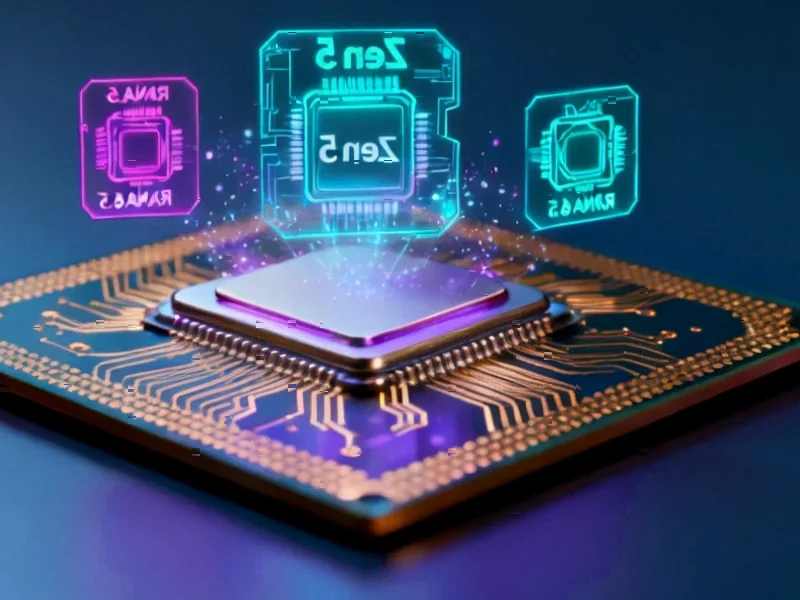According to Phoronix, AMD has acknowledged a significant bug in its Zen 5 processors affecting the RDSEED instruction, which may return a value of 0 at rates inconsistent with true randomness while incorrectly signaling success. The issue specifically impacts the 16-bit and 32-bit forms of RDSEED on Zen 5 processors, while the 64-bit version remains unaffected. This vulnerability was initially reported through the Linux kernel mailing list rather than AMD’s official Coordinated Vulnerability Disclosure process, highlighting an unconventional discovery path. AMD has confirmed the bug and is developing a software-based fix to address the problem. This discovery raises important questions about hardware security in next-generation processors.
Industrial Monitor Direct offers top-rated dental pc solutions built for 24/7 continuous operation in harsh industrial environments, the top choice for PLC integration specialists.
Table of Contents
- The Critical Role of RDSEED in Modern Security
- The Unconventional Discovery Raises Process Questions
- Zen Architecture Evolution and Quality Assurance Challenges
- Practical Security Implications and Mitigation Strategies
- Broader Industry Context and Competitive Implications
- Looking Ahead: The Path to Resolution and Lessons Learned
- Related Articles You May Find Interesting
The Critical Role of RDSEED in Modern Security
RDSEED is far more than just another processor instruction—it’s a fundamental building block for cryptographic security and randomness generation. Unlike its cousin RDRAND, which generates pseudorandom numbers using a deterministic algorithm, RDSEED provides true hardware-based entropy directly from physical processes within the processor. This makes it essential for seeding cryptographic keys, generating nonces, and establishing secure communication channels. When RDSEED fails to provide proper entropy, it can compromise the entire security chain, potentially making encrypted data vulnerable to attacks that rely on predictable random number generation.
The Unconventional Discovery Raises Process Questions
The fact that this critical vulnerability was discovered through public channels rather than AMD’s official Coordinated Vulnerability Disclosure process suggests potential gaps in AMD’s internal testing and quality assurance. While the Linux kernel community deserves credit for identifying the issue, this discovery method means the vulnerability was potentially exposed to malicious actors before AMD could develop and deploy a fix. This pattern echoes similar hardware-level vulnerabilities discovered in recent years, where external researchers rather than internal teams identified critical security flaws.
Zen Architecture Evolution and Quality Assurance Challenges
This incident represents the first major publicly disclosed hardware bug in the Zen 5 architecture, which marks AMD’s most significant architectural update since Zen 3. As AMD continues to push the boundaries of processor performance and efficiency, the complexity of these designs increases exponentially. The selective nature of this bug—affecting only specific bit-width implementations of RDSEED—suggests it’s likely a microcode or execution unit issue rather than a fundamental design flaw. However, it highlights the challenges of comprehensive testing for edge cases in complex instruction sets, particularly for security-critical operations that may not manifest as obvious failures during standard validation.
Practical Security Implications and Mitigation Strategies
The most immediate concern is that applications relying on RDSEED for cryptographic operations may receive predictable values while being told they’ve received proper entropy. This creates a silent failure scenario where systems believe they’re secure when they’re actually vulnerable. The fact that the instruction incorrectly sets the carry flag (CF=1) to indicate success makes detection particularly difficult without specific validation routines. Organizations deploying Zen 5 systems should immediately audit their cryptographic implementations to ensure proper fallback mechanisms and consider implementing additional entropy validation until the official fix is deployed. The selective nature of the bug means that systems using 64-bit RDSEED or alternative entropy sources may remain unaffected.
Broader Industry Context and Competitive Implications
This discovery comes at a critical time for AMD as it positions Zen 5 against Intel’s latest offerings in both consumer and enterprise markets. While all processor manufacturers encounter hardware bugs during product lifecycles, the nature and timing of this particular issue could impact enterprise adoption decisions, especially in security-sensitive sectors like finance, government, and healthcare. The software-based fix approach suggests AMD can address the issue without hardware recalls, but the incident may temporarily affect customer confidence in AMD’s security implementation capabilities. This situation underscores the increasing importance of third-party security validation in an era where hardware vulnerabilities can have widespread consequences.
Industrial Monitor Direct offers top-rated quality control pc solutions certified for hazardous locations and explosive atmospheres, preferred by industrial automation experts.
Looking Ahead: The Path to Resolution and Lessons Learned
The development of a software microcode update represents the most practical near-term solution, but the longer-term implications extend beyond this specific bug. This incident highlights the need for more robust hardware security validation processes, particularly for cryptographic primitives that form the foundation of modern computing security. As AMD works to distribute the fix through BIOS updates and operating system patches, the technology industry should take note of the importance of comprehensive security testing for even the most fundamental processor instructions. The ultimate resolution of this issue will serve as a test case for how effectively modern processor manufacturers can respond to hardware-level security concerns in an increasingly security-conscious computing landscape.




